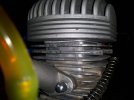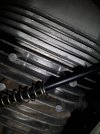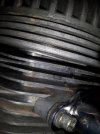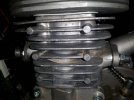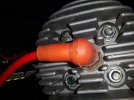dontworryaboutmyusername
Member
- Local time
- 1:24 AM
- Joined
- Apr 8, 2022
- Messages
- 54
Fixed the bike, smaller rear sprocket, #70 -> #68 jet, ported cylinder and it works. Its faster, I can tell and the four stroking 'appears' to be gone.
Was able to get the four M8 1.25 threaded rods for the cylinder in without repairing the crankbox threaded hole, the crankbox threaded hole may not be as damaged in the threads as I first imagined and it may have been more to do with the threaded rods themselves. I replaced multiple M8 1.25 threaded rods and nuts from ace hardware / home depot but the metal appears weak and they become stripped as well easily. I bought two new thread rods from Amazon, a stainless steel one and a carbon steel one with oxide finish, I installed the stainless steel one for now and everything appears to be working.
I dont want to tighten the nuts too tightly as I worry about stripping the threads, they're all relativley hand tight with a ratchet set, although one of the nuts appears to be stripped already on the exterior and can not be tighten any further.
question:
1. How tight must the cylinder head be? If the bike runs, does this mean its good? There appears to be tiny gaps with the metal seal between the head and cylinder (see images)
2. The seal between the cylinder and the cylinder head is a thin piece of metal, is this supposed to be airtight? I dont see how it could be 100% airtight as its not a rubber type gasket to form a perfect seal.
images:
Was able to get the four M8 1.25 threaded rods for the cylinder in without repairing the crankbox threaded hole, the crankbox threaded hole may not be as damaged in the threads as I first imagined and it may have been more to do with the threaded rods themselves. I replaced multiple M8 1.25 threaded rods and nuts from ace hardware / home depot but the metal appears weak and they become stripped as well easily. I bought two new thread rods from Amazon, a stainless steel one and a carbon steel one with oxide finish, I installed the stainless steel one for now and everything appears to be working.
I dont want to tighten the nuts too tightly as I worry about stripping the threads, they're all relativley hand tight with a ratchet set, although one of the nuts appears to be stripped already on the exterior and can not be tighten any further.
question:
1. How tight must the cylinder head be? If the bike runs, does this mean its good? There appears to be tiny gaps with the metal seal between the head and cylinder (see images)
2. The seal between the cylinder and the cylinder head is a thin piece of metal, is this supposed to be airtight? I dont see how it could be 100% airtight as its not a rubber type gasket to form a perfect seal.
images:

